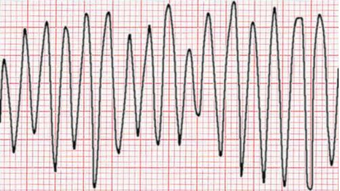Medicine:Ventricular flutter
From HandWiki
| Ventricular flutter | |
|---|---|
 |
Ventricular flutter is an arrhythmia, more specifically a tachycardia affecting the ventricles with a rate over 250-350 beats/min, and one of the most indiscernible. It is characterized on the ECG by a sinusoidal waveform without clear definition of the QRS and T waves. It has been considered as a possible transition stage between ventricular tachycardia and fibrillation, and is a critically unstable arrhythmia that can result in sudden cardiac death.[citation needed][1]
It can occur in infancy,[2] youth,[3] or as an adult.
It can be induced by programmed electrical stimulation.[4][5]
References
- ↑ "Heart Ventricle Flutter - an overview | ScienceDirect Topics". https://www.sciencedirect.com/topics/medicine-and-dentistry/heart-ventricle-flutter.
- ↑ "Ventricular flutter in a neonate--severe electrolyte imbalance caused by urinary tract infection in the presence of urinary tract malformation". J Emerg Med 18 (1): 47–50. January 2000. doi:10.1016/S0736-4679(99)00161-4. PMID 10645837.
- ↑ "Sudden nocturnal death in young males from ventricular flutter". Jpn Heart J 26 (4): 585–91. July 1985. doi:10.1536/ihj.26.585. PMID 4057556.
- ↑ "Long-term prognosis of inducible ventricular flutter: not an innocent finding". Am. Heart J. 147 (4): 649–54. April 2004. doi:10.1016/j.ahj.2003.11.012. PMID 15077080.
- ↑ "Ventricular flutter induced during electrophysiologic studies in patients with old myocardial infarction: clinical and electrophysiologic predictors, and prognostic significance". J. Cardiovasc. Electrophysiol. 14 (9): 913–9. September 2003. doi:10.1046/j.1540-8167.2003.03082.x. PMID 12950532.
External links
| Classification |
|---|
 |

